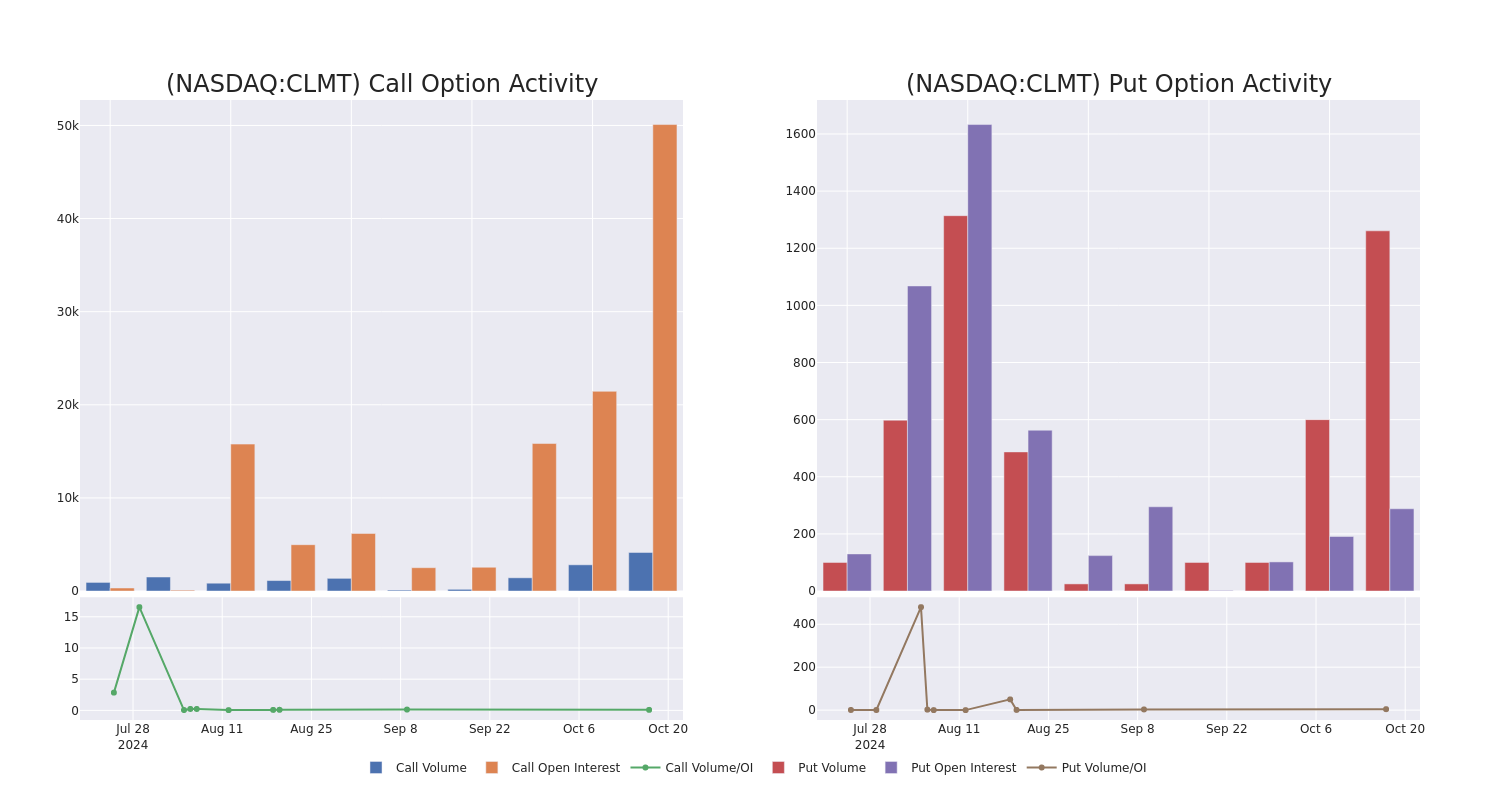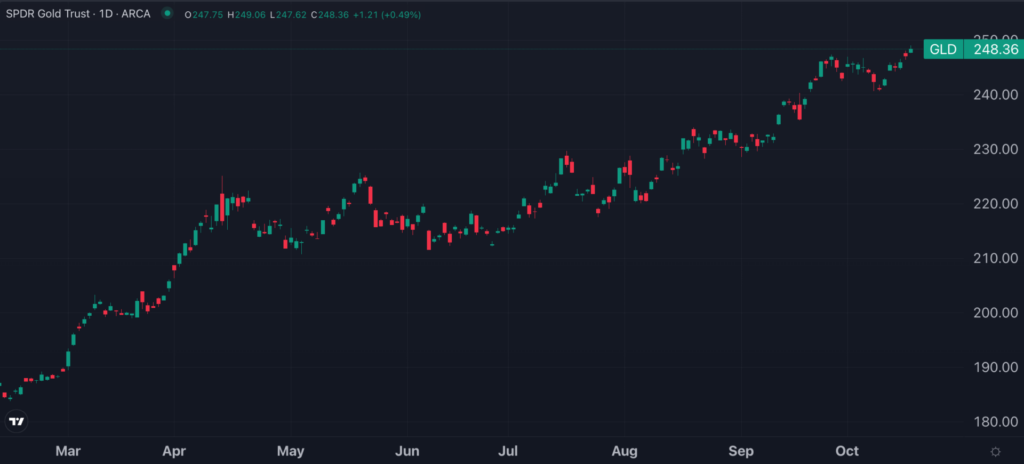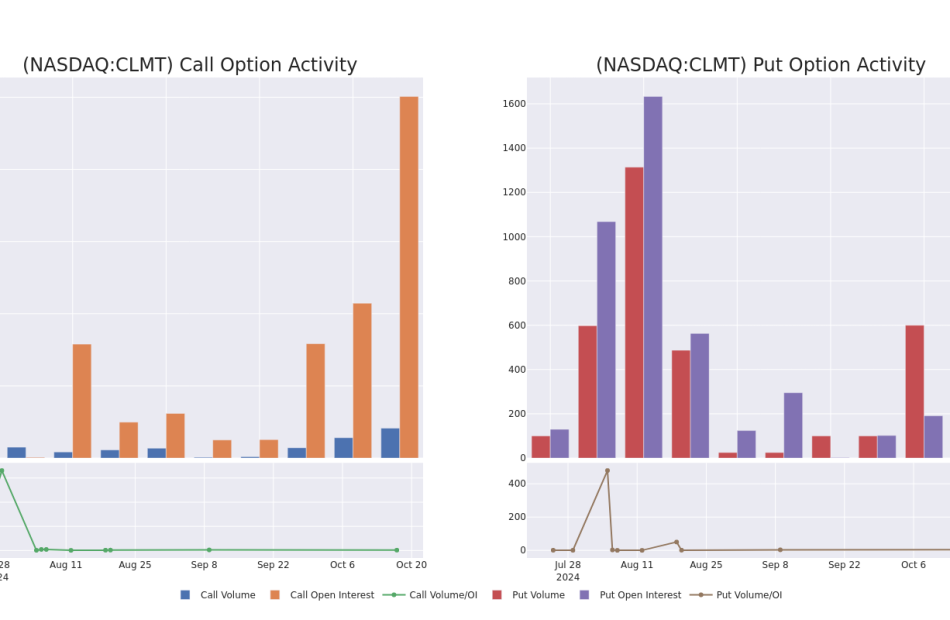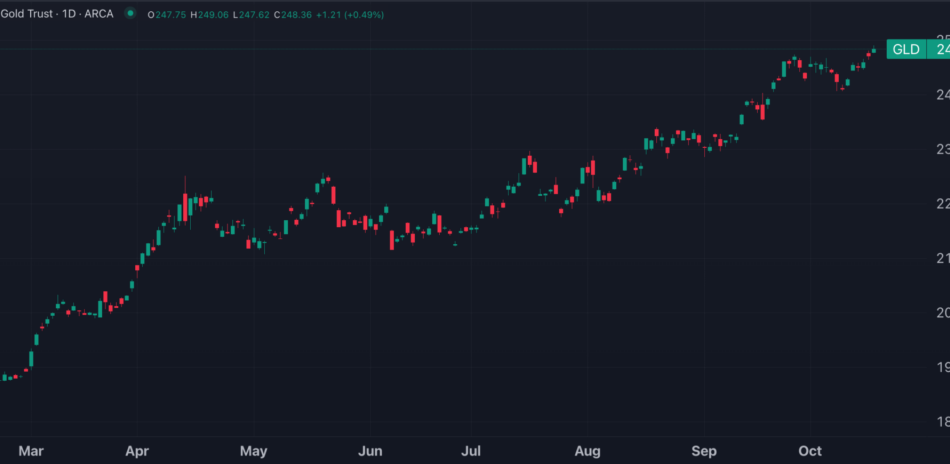Strong September Retail Sales Put Fed's Next Move In Doubt: Interest Rate Cuts Are 'Not A Slam Dunk'
A sharp rise in September retail sales is sparking fresh debate among economists about the Federal Reserve’s next move, as stronger-than-expected consumer resilience raises doubts about the need for further interest rate cuts.
Retail sales rose 0.4% month-over-month in the last month of the quarter, far exceeding the 0.1% growth recorded in August and surpassing economists’ forecasts of 0.3%. Even more notably, excluding volatile sectors like autos and gasoline, sales surged by 0.7%, marking the second-largest increase over the past 12 months.
The stronger-than-expected sales report is pushing analysts to rethink whether the Federal Reserve will move forward with another interest rate cut in November. While market participants overwhelmingly anticipate a 25 basis point reduction following the 50-basis-point move last month, the latest economic data may complicate that outlook.
Economists Debate On Fed Interest Rates
Quincy Krosby, chief global strategist at LPL Financial, said, “Retail sales came in well above expectations and continue to defy the weak economy thesis.”
Krosby added that the key question for monetary policy is whether the Fed will be concerned that the economy’s renewed strength could drive inflation higher.
However, she expects that a 25-basis-point cut will occur, especially if hurricane damage significantly impacts the labor market.
Speaking to CNBC, Stifel chief economist Lindsey Piegza said, “I think this was a very strong number and underscores the notion that the Fed maybe took too big of a step out of the gate with that 50 basis point cut.” Looking ahead, Piegza explained that there’s a stronger argument for a more patient approach, potentially holding off on a November cut.
Kathy Bostjancic, chief economist at Nationwide, also commented on the retail data: “That’s positive, right, for the overall economy. It’s really big consumer spending buoying the overall GDP growth in the US.”
Regarding the next Fed moves, Bostjancic added that “it’s not a slam dunk that they will cut rates.”
LPL Financial’s chief economist Jeffrey Roach maintains that the Fed will proceed with gradual cuts.
“Strong consumer spending in September suggests economic growth in the previous quarter was solidly above trend. Looking ahead, investors need to monitor any signs that the unemployed are finding it more difficult to earn a paycheck. Our baseline remains that the Fed will likely cut a quarter of a percent in both November and December.” Roach said.
Investors still largely anticipate a cut at the upcoming Fed meeting. Market-implied odds of a 25-basis-point rate cut in November dipped only slightly from 94% to 87% on Thursday.
Market Reactions: Treasury Yields Rise, Gold Hits Record Highs
Stronger-than-expected retail sales data, combined with a drop in unemployment claims, sparked a sharp rise in Treasury yields on Thursday, putting the brakes on further stock market gains.
The yield on the 10-year Treasury jumped 8 basis points to 4.10%, while the 30-year yield surged 9 basis points to 4.39%. This spike in yields hit Treasury-related assets hard, with the iShares 20+ Year Treasury Bond ETF TLT tumbling 1.5%. The surge in Treasury yields weighed on investor risk sentiment.
After opening 0.6% higher to fresh record highs, the S&P 500 was up just 0.3% by 12:15 p.m. in New York. The tech-heavy Nasdaq 100, tracked by the Invesco QQQ Trust QQQ, which had risen over 1% at the open, was up 0.7% at the time of publication.
Meanwhile, gold prices, as tracked by the SPDR Gold Trust GLD, rose 0.7%, hitting new all-time highs.
Read Next:
Image created using artificial intelligence via Midjourney.
Market News and Data brought to you by Benzinga APIs
© 2024 Benzinga.com. Benzinga does not provide investment advice. All rights reserved.
What the Options Market Tells Us About Calumet
Investors with a lot of money to spend have taken a bearish stance on Calumet CLMT.
And retail traders should know.
We noticed this today when the positions showed up on publicly available options history that we track here at Benzinga.
Whether these are institutions or just wealthy individuals, we don’t know. But when something this big happens with CLMT, it often means somebody knows something is about to happen.
Today, Benzinga’s options scanner spotted 14 options trades for Calumet.
This isn’t normal.
The overall sentiment of these big-money traders is split between 28% bullish and 50%, bearish.
Out of all of the options we uncovered, there was 1 put, for a total amount of $40,200, and 13, calls, for a total amount of $1,144,494.
What’s The Price Target?
After evaluating the trading volumes and Open Interest, it’s evident that the major market movers are focusing on a price band between $13.0 and $40.0 for Calumet, spanning the last three months.
Analyzing Volume & Open Interest
In terms of liquidity and interest, the mean open interest for Calumet options trades today is 4198.58 with a total volume of 5,404.00.
In the following chart, we are able to follow the development of volume and open interest of call and put options for Calumet’s big money trades within a strike price range of $13.0 to $40.0 over the last 30 days.
Calumet Option Volume And Open Interest Over Last 30 Days

Significant Options Trades Detected:
| Symbol | PUT/CALL | Trade Type | Sentiment | Exp. Date | Ask | Bid | Price | Strike Price | Total Trade Price | Open Interest | Volume |
|---|---|---|---|---|---|---|---|---|---|---|---|
| CLMT | CALL | SWEEP | BULLISH | 01/17/25 | $9.5 | $9.3 | $9.5 | $15.00 | $475.0K | 1.8K | 0 |
| CLMT | CALL | SWEEP | BEARISH | 01/17/25 | $3.5 | $3.0 | $3.0 | $26.00 | $135.0K | 5 | 601 |
| CLMT | CALL | TRADE | BULLISH | 01/17/25 | $3.7 | $2.95 | $3.4 | $25.00 | $85.0K | 11.6K | 251 |
| CLMT | CALL | TRADE | BEARISH | 12/20/24 | $1.75 | $1.5 | $1.55 | $30.00 | $77.5K | 11 | 500 |
| CLMT | CALL | SWEEP | BEARISH | 11/15/24 | $3.8 | $3.6 | $3.6 | $20.00 | $72.0K | 1.2K | 214 |
About Calumet
Calumet Inc is a producer of specialty products, including base oils, specialty oils, solvents, esters, and waxes, as well as a variety of fuel and fuel-related products, including asphalt and heavy fuel oils. The company manufactures, formulates, and markets a variety of specialty branded products to customers in various consumer-facing and industrial markets.
After a thorough review of the options trading surrounding Calumet, we move to examine the company in more detail. This includes an assessment of its current market status and performance.
Where Is Calumet Standing Right Now?
- With a volume of 1,520,256, the price of CLMT is up 15.37% at $25.3.
- RSI indicators hint that the underlying stock may be overbought.
- Next earnings are expected to be released in 21 days.
What The Experts Say On Calumet
A total of 2 professional analysts have given their take on this stock in the last 30 days, setting an average price target of $25.0.
Turn $1000 into $1270 in just 20 days?
20-year pro options trader reveals his one-line chart technique that shows when to buy and sell. Copy his trades, which have had averaged a 27% profit every 20 days. Click here for access.
* An analyst from HC Wainwright & Co. has revised its rating downward to Buy, adjusting the price target to $25.
* In a cautious move, an analyst from HC Wainwright & Co. downgraded its rating to Buy, setting a price target of $25.
Options trading presents higher risks and potential rewards. Astute traders manage these risks by continually educating themselves, adapting their strategies, monitoring multiple indicators, and keeping a close eye on market movements. Stay informed about the latest Calumet options trades with real-time alerts from Benzinga Pro.
Market News and Data brought to you by Benzinga APIs
© 2024 Benzinga.com. Benzinga does not provide investment advice. All rights reserved.
Gold Could Reach $3,000 By 2025, Bank Of America Analyst Says: 'Ultimate Perceived Safe Haven'
Bank of America released a bullish note on gold Thursday, just as the precious metal reached new record highs at $2,696 per ounce (oz).
Gold remains “the ultimate perceived safe haven asset” in today’s macroeconomic environment, according to Bank of America’s commodity analyst Michael Widmer, amid rising concerns over U.S. fiscal policies and their potential impact on Treasury yields.
Gold Trends Higher As Fed Shifts Policy
Despite nominal U.S. Treasury yields trending upward, gold prices, as tracked by the SPDR Gold Trust GLD, have been climbing in recent weeks, supported by various factors.
Widmer explained that a key driver behind this surge is the rising inflation expectations paired with the Federal Reserve’s policy shifts.
Rate cuts triggered a surge in inflation expectations, which in turn kept downward pressure on real yields, increasing gold’s appeal as an inflation hedge.
“Accompanying the first Fed’s 50bp rate cut, inflation expectations have risen, meaning that 10-year real yields, usually the most significant gold price driver, kept declining through September,” Widmer said.
Gold Hits All-Time Highs On Oct. 17

U.S. Fiscal Policy Boosts Bullish Gold Outlook
A key factor bolstering Bank of America’s bullish stance on gold is the U.S.’s fiscal trajectory.
Rising interest rates have significantly increased the federal government’s debt servicing costs, triggering concerns about fiscal sustainability. According to government projections, the national debt is projected to reach a new record high as a share of the U.S. economy within the next three years.
Widmer highlighted that “whoever wins the 2024 presidential election will face an unprecedented fiscal situation upon taking office. Neither Kamala Harris nor Donald Trump seems to prioritize fiscal consolidation.”
The CRFB report details that Vice President Harris’s proposed policies could increase the national debt by $3.5 trillion through 2035, while former President Trump’s platform might raise it by as much as $7.5 trillion. “
The large and growing national debt threatens to “to slow economic growth, boost interest rates and payments, weaken national security, constrain policy choices, and raise the risk of an eventual fiscal crisis.”
Global Trends Also Favor Gold
According to Widmer, fiscal expansion policies are gaining traction across advanced economies, contributing to gold’s global appeal. The International Monetary Fund (IMF) estimates that new fiscal spending related to climate adaptation, demographic shifts, and rising defense costs could amount to 7-8% of global GDP annually by 2030.
This massive spending will likely force governments to issue more debt, and as volatility in the bond markets rises, gold will emerge as a refuge for investors, Widmer explained.
Central banks are also anticipated to increase their gold holdings as part of currency reserve diversification. The share of global central bank reserves held in gold has climbed to 10%, up from just 3% a decade ago.
Outlook for Gold: $3,000/oz By 2025
Bank of America sees gold reaching the $3,000/oz mark by the first half of 2025. The combination of macroeconomic uncertainty, rising debt levels, and central bank buying makes gold the “last safe haven asset standing.”
Read Next:
Photo: Shutterstock
Market News and Data brought to you by Benzinga APIs
© 2024 Benzinga.com. Benzinga does not provide investment advice. All rights reserved.
Realty Income: A Dividend Powerhouse With Growth Potential
Realty Income Corporation O, known as “The Monthly Dividend Company,” is a Real Estate Investment Trust (REIT) with a unique approach to commercial real estate. Unlike many of its peers, Realty Income focuses exclusively on free-standing properties, securing them under long-term net lease agreements.
This strategy provides investors with a dependable stream of passive income generated by a diversified portfolio of high-quality tenants. This business model, combined with a commitment to consistent dividend payouts and strategic acquisitions, has fueled Realty Income’s impressive growth and positioned it as a favorite among investors seeking reliable income and long-term growth potential.
The Triple-Net Lease Advantage
Realty Income’s triple-net lease model is a cornerstone of its business strategy, further reinforcing the company’s commitment to efficient operations and predictable cash flows. This model, where tenants shoulder the responsibility for property taxes, maintenance, and utilities, minimizes Realty Income’s operational expenses, making it easier to forecast earnings and plan for future dividend payments.
This structure also offers tenants significant flexibility, allowing them to focus on their core business operations while securing long-term occupancy of their facilities. For example, Realty Income’s portfolio includes properties leased to a diverse range of tenants, from national retailers like Walgreens WBA and Dollar General DG to regional and local businesses. This strategy has enabled Realty Income to generate a steady stream of passive income, which has fueled its consistent dividend payments and impressive long-term growth.
The Monthly Dividend Advantage
Realty Income is known as “The Monthly Dividend Company,” representing its commitment to paying consistent dividends every month.
This approach has differentiated the company in the REIT market, appealing to investors who prefer a regular, steady income stream.
Since its initial public offering (IPO) in 1994, Realty Income has consistently increased its dividend payment 127 times, a testament to its commitment to shareholder value.
Realty Income’s dividend history has solidified its reputation as a reliable income source, drawing investors seeking dependable and growing dividend income.
Realty Income’s Growth and Financial Performance
Realty Income’s earnings report for the second quarter of 2024 underscores its ability to deliver consistent growth. Realty Income reported earnings per share (EPS) of $0.29, slightly missing analysts’ consensus estimates of $0.36. However, it’s crucial to look at the bigger picture. While the EPS did not meet Realty Income’s analyst community’s expectations, the company’s revenue reached $1.34 billion, representing a robust 31.4% increase year-over-year. This solid revenue growth reflects Realty Income’s ability to acquire high-quality properties and maintain consistent occupancy rates.
This recent performance also saw Realty Income declare a monthly dividend increase, raising the payment to $0.2635 per share from $0.2630 per share. This increase, representing an annualized dividend amount of $3.162 per share, further highlights the company’s commitment to rewarding its shareholders with growing dividend income.
Realty Income’s Diversification Strategy
Realty Income’s diversification strategy is a key factor in its long-term growth. The company has expanded its portfolio to include properties in the US, UK, and Spain, spreading its geographic reach and mitigating risk. This proactive risk management offers several advantages for investors, reducing portfolio volatility and increasing returns. By diversifying across multiple markets, Realty Income is better positioned to withstand potential economic downturns and maintain steady growth regardless of local market conditions.
Realty Income’s Secret Sauce
Realty Income’s success is driven by a combination of factors that give the company a significant competitive advantage. The company’s focus on triple-net leases minimizes its operational expenses, providing a more predictable cash flow for investors. Realty Income’s diversification strategy, extending its reach across industries and geographies, further enhances its ability to weather economic fluctuations.
Furthermore, Realty Income’s strong balance sheet and deep industry experience allow it to attract high-quality tenants. These tenants are willing to commit to long-term lease agreements, providing the company with a steady stream of rental income that supports its consistent dividend payments.
Strategies for Different Investors
Investing in Realty Income requires careful consideration of personal investment goals and risk tolerance. While the company is attractive to a wide range of investors, two primary strategies stand out for different investor profiles:
Income-Focused Investors
Realty Income is an attractive option for those seeking a dependable stream of dividend income. The company’s commitment to shareholder value and history of consistent dividend payments, including a track record of 652 consecutive monthly dividend payments, make it a strong contender for investors seeking a reliable source of income. This consistent payout, combined with its triple-net lease model, which minimizes operating expenses for Realty Income, creates a stable and predictable cash flow stream that supports these dividends.
Growth-Oriented Investors
While Realty Income’s primary focus is on dividends, the company has also demonstrated consistent growth in its portfolio and share price. Growth-oriented investors can consider Realty Income as a core holding within a diversified portfolio. The company’s strategic acquisitions, expansion into new markets, and strong tenant relationships provide a solid foundation for continued growth, offering investors the potential for income and capital appreciation. Realty Income’s global diversification strategy, with a presence in the US, UK, and Spain, further mitigates risk and creates opportunities for growth in various markets.
Realty Income has carved a unique niche in the REIT sector by focusing on triple-net leases and offering investors dependable monthly dividend payments. The company’s consistent growth, diversification strategy, and competitive advantages have solidified its reputation as a reliable income source. Investors seeking a dependable dividend stream and potential for long-term growth may find Realty Income an attractive investment opportunity.
The article “Realty Income: A Dividend Powerhouse With Growth Potential” first appeared on MarketBeat.
© 2024 Benzinga.com. Benzinga does not provide investment advice. All rights reserved.
Aluminum Door and Window Market to Reach $82.1 billion, Globally, by 2031 at 3.8% CAGR: Allied Market Research
Wilmington, Delaware, Oct. 17, 2024 (GLOBE NEWSWIRE) — Allied Market Research published a report, titled, “Aluminum Door and Window Market by Product Type (Window and Door), Mechanism (Swinging, Sliding, Folding and Revolving), And End User Industry (Residential, Non-Residential): Global Opportunity Analysis and Industry Forecast, 2022-2031“. The global aluminum door and window market was valued at $55.8 billion in 2021 and is estimated to reach $82.1 billion by 2031, exhibiting a CAGR of` 3.8% from 2022 to 2031.
Prime determinants of growth
The aluminum door and window market is primarily driven by the increasing consumer preference for energy-efficient and sustainable building materials. Aluminum’s lightweight yet durable properties, with its resistance to corrosion, make it an ideal choice for both residential and non-residential applications. In addition, advancements in manufacturing techniques have improved design flexibility and reduced costs. The growing trend towards modern architecture, which often emphasizes large glass areas and minimalistic designs, further boosts demand for aluminum frames. Moreover, government initiatives promoting eco-friendly construction practices and energy conservation continue to support the expansion of this market segment.
Download PDF Sample Copy: https://www.alliedmarketresearch.com/request-sample/A16982
Report coverage & details:
| Report Coverage | Details |
| Forecast Period | 2021–2031 |
| Base Year | 2021 |
| Market Size in 2023 | $55.8 billion |
| Market Size in 2032 | $82.1 billion |
| CAGR | 3.8% |
| No. of Pages in Report | 240 |
| Segments Covered | Product Type, Mechanism, End User Industry and Region. |
| Drivers |
|
| Opportunities |
|
| Restraint |
|
The window is expected to exhibit fastest growth throughout the forecast period
By product type, the window is anticipated to experience faster growth in the aluminum door and window market due to the rise in construction of residential building which is expected to positively influence the demand of aluminum windows. Moreover, improving lifestyle of people in general and rise in trend of saving energy by letting in more and more ambient light is expected to drive the demand for aluminum windows. Moreover, manufacturers such as Andersen Corporation, Apogee Enterprises, Inc., and Bradnam’s Windows & Doors offer a wide range of aluminum windows.
Buy This Research Report (210 Pages PDF with Insights, Charts, Tables, Figures) https://bit.ly/3YjZyRN
The sliding segment are expected to exhibit fastest growth throughout the forecast period
By mechanism, the sliding segment is anticipated to experience faster growth in the aluminum door and window market. The sliding mechanism is suitable for residential buildings, hotels, offices, apartments, big retail outlets, airports, and other building projects. Some of the benefits associated with this mechanism include, substantial cost savings and do not take up a larger space. Moreover, increase in popularity of this mechanism among consumers, and rise in new construction and home improvement activities are expected to further boost the market expansion.
The non-residential segment is expected to exhibit fastest growth throughout the forecast period
By end user, the non-residential segment is anticipated to experience faster growth in the aluminum door and window market due to the rapid rise in urbanization. Moreover, rise in global population has also positively affected the global non-residential building construction. Aluminum doors and windows are widely used in non-residential buildings, owing to their highly desirable features for places witnessing high foot fall of people. Aluminum doors and windows are strong, durable, and easy to maintain. All such features are required by a door and window installed in non-residential buildings, as they are constantly opened and closed. Hence, an increase in investments in non-residential construction projects is expected to drive the growth of the aluminum door and window market.
Inquire Before Buying: https://www.alliedmarketresearch.com/purchase-enquiry/A16982
LAMEA is expected to exhibit fastest growth throughout the forecast period
Asia-Pacific accounted for the highest market share in 2021. However, LAMEA is expected to grow with a highest CAGR during the forecast period. Latin America and Middle East have a large number of developing countries with a huge potential to grow. Many countries in the Middle East are focusing on rapid development of infrastructure for boosting the tourism industry. This creates a demand for hotels, resorts, and other guests’ accommodation; thereby increasing the demand for doors and windows.
Players: –
- Apogee Enterprises Inc.
- Bradnam’s Windows & Doors
- Contractors Wardrobe, Inc.
- Fenesta Building Systems
- Fletcher Building Limited
- Geeta Aluminum Co. Pvt. Ltd.
- Hume Doors & Timber Pty Ltd.
- Marvin Windows and Doors
Key Strategies
- In December 2021- Alumil launched three new products, namely SΜΑΡΤΙΑ P100 Slim, SMARTIA P200 Slim, and SMARTIA P150 Urban to enhance working circumstances such as privacy, natural sunlight, and overall appearance.
- In July 2021- Alumil developed an advanced sliding aluminum window (S650e-Motion) that operates with electric motion.
The report provides a detailed analysis of these key players in the global aluminum door and window. These players have adopted different strategies such as new product launches, collaborations, expansion, joint ventures, agreements, and others to increase their market share and maintain dominant shares in different regions. The report is valuable in highlighting business performance, operating segments, product portfolio, and strategic moves of market players to showcase the competitive scenario.
Trending Reports
Residential Wooden Doors Market Size, Share, Competitive Landscape and Trend Analysis Report
U.S. Barn Door Hardware Market Size, Share, Competitive Landscape and Trend Analysis Report
Fiberglass Doors Market Size, Share, Competitive Landscape and Trend Analysis Report
India Fire Rated Metal Doors Market Size, Share, Competitive Landscape and Trend Analysis Report
North America Doors Market Size, Share, Competitive Landscape and Trend Analysis Report
Plastic door and window market Size, Share, Competitive Landscape and Trend Analysis Report
Smart Door Locks Market Size, Share, Competitive Landscape and Trend Analysis Report
About us:
Allied Market Research (AMR) is a full-service market research and business-consulting wing of Allied Analytics LLP based in Wilmington, Delaware. Allied Market Research provides global enterprises as well as medium and small businesses with unmatched quality of “Market Research Reports” and “Business Intelligence Solutions.” AMR has a targeted view to provide business insights and consulting to assist its clients to make strategic business decisions and achieve sustainable growth in their respective market domain.
We are in professional corporate relations with various companies and this helps us in digging out market data that helps us generate accurate research data tables and confirms utmost accuracy in our market forecasting. Allied Market Research CEO Pawan Kumar is instrumental in inspiring and encouraging everyone associated with the company to maintain high quality of data and help clients in every way possible to achieve success. Each and every data presented in the reports published by us is extracted through primary interviews with top officials from leading companies of domain concerned. Our secondary data procurement methodology includes deep online and offline research and discussion with knowledgeable professionals and analysts in the industry.
Contact us:
Wilmington, Delaware
1209 Orange Street,
Corporation Trust Center,
Wilmington, New Castle, Delaware 19801 USA.
Int’l: +1-503-894-6022
Toll Free: +1-800-792-5285
Fax: +1-800-792-5285
help@alliedmarketresearch.com

© 2024 Benzinga.com. Benzinga does not provide investment advice. All rights reserved.
Ask an Advisor: I'm Facing a Massive Tax Bill from Investment Gains – What Are My Options?
My investment accounts don’t withhold taxes from my capital gains, which is causing me to owe large amounts when I file my returns. How can I mitigate this situation?
-David
As capital gains distributions are unpredictable and usually unknown until the end of the year, it can be difficult to properly plan for them. Taking proactive steps to anticipate and “prepay” your tax bill can help you avoid an unmanageable balance due in April.
Read on for more information on how to manage your tax liability throughout the year. (Looking for help with a financial question? This tool can help match you with potential advisors.)
Options to ‘Prepay’ Your Tax Bill
You have two main options for paying taxes throughout the year rather than dealing with a huge tax bill in April: adding or increasing withholding taxes from another income source, or making quarterly estimated tax payments.
A third possible option would be to contact the mutual fund generating the capital gains distributions directly and ask it about withholding. It’s possible that the company would facilitate that but not likely. As for your investment account, those institutions typically only offer withholding when you sell securities or take retirement account distributions.
Be aware that using these strategies will reduce the balance you have to pay when you file your taxes. But they won’t reduce your actual tax bill. (Looking for help with a financial question? This tool can help match you with potential advisors.)
What Are Capital Gains Distributions?
Mutual funds and exchange-traded funds (ETFs) hold lots of underlying investments like stocks and bonds. During the year, they may sell some of those investments, resulting in capital gains or losses inside the fund. At the end of the year, the fund distributes a proportional share of those sale proceeds to each investor – that’s a capital gains distribution.
As an investor, you generally won’t know what to expect in terms of capital gain distribution income until late in the year. Funds typically post information about estimated distributions and expected payout dates on their websites in November or December.
Unlike regular capital gains, which come into play when you sell an investment for more than its purchase price, you haven’t taken any action here. Your capital gains distribution is purely the result of trades that the fund itself made. So even though you haven’t sold any shares of your mutual fund, you’ll have taxable income from those capital gains distributions.
This income will be taxed like long-term capital gains, no matter how long you’ve actually owned your fund shares. Long-term capital gains tax rates are based on your overall taxable income and filing status, so this income will be taxed at either 0%, 15% or 20%.
How Can I Deal With These Taxes?
Since you won’t know until late in the year how much you might receive in capital gains distributions, it can be tough to estimate the tax bill exactly – but you can get close enough to at least avoid IRS underpayment penalties. The IRS has safe harbor guidelines: As long as you pay at least 90% of your current tax bill or 100% of the prior year’s tax bill, or owe less than $1,000, you can avoid being charged underpayment penalties even if you end up owing.
Both methods ask you to have a good sense of what your annual income will be early in the year, which isn’t always practical. You can start with your best estimate and make adjustments during the year if needed. (Looking for help with a financial question? This tool can help match you with potential advisors.)
Begin or Increase Withholding on Other Income
If you have other income sources, such as a regular W-2 job or federal retirement income, you can request that they enough withhold taxes to cover this additional income. You can even request withholding on Social Security payments.
If you have an online account for your other income source, you can probably request or change withholding taxes right there. You’ll complete a Form W-4 (or the equivalent) and enter the amount you want withheld on the line that says “extra withholding.” For government payments like Social Security, you’ll use Form W-4V and choose the percent you want withheld. You can also stop this withholding at any time by updating your choices.
Make Quarterly Estimated Tax Payments
Once you know approximately how much tax you’ll owe, you can divide that by four and make equal estimated tax payments every quarter. You can either complete IRS Form 1040-ES and mail that with a check to your designated IRS mailing center or make your payment online at the IRS website. If you pay online, make sure you choose “Estimated Tax” for the reason and the correct current tax year.
Pro tip: When making estimated tax payments for a jointly filed tax return, make sure to use the Social Security number of whichever of you appears first on the tax return (as “taxpayer” rather than as “spouse”). The IRS system sometimes misapplies or does not apply payments properly if the other SSN is used.
Estimated tax due date payments are:
Estimated Tax Payments vs. Withholding Taxes
Be aware that there are more potential penalties associated with estimated tax payments than withholding taxes. It’s also a lot easier to manage withholding as you can set it and forget it, as opposed to remembering to proactively make a payment every quarter. (Looking for help with a financial question? This tool can help match you with potential advisors.)
Next Steps
There are two ways to avoid paying a large tax bill in April. You can withhold extra taxes on another source of income or make quarterly estimated tax payments. Either way, you’ll be spreading out your taxes over the whole year instead of coming up with a lump sum when you file your tax return.
Find a Financial Advisor
-
If you have questions specific to your investing and taxation situation, a financial advisor can help. Finding a financial advisor doesn’t have to be hard. SmartAsset’s free tool matches you with up to three vetted financial advisors who serve your area, and you can interview your advisor matches at no cost to decide which one is right for you. If you’re ready to find an advisor who can help you achieve your financial goals, get started now.
-
Understanding your tax bill can help you make plans for your money. Whether you plan on saving for retirement, paying off college or credit card debt, or investing your money differently, SmartAsset’s tax return calculator can help you figure out how much you will get back from the government so you can plan ahead.
-
Keep an emergency fund on hand in case you run into unexpected expenses. An emergency fund should be liquid — in an account that isn’t at risk of significant fluctuation like the stock market. The tradeoff is that the value of liquid cash can be eroded by inflation. But a high-interest account allows you to earn compound interest. Compare savings accounts from these banks.
-
Are you a financial advisor looking to grow your business? SmartAsset AMP helps advisors connect with leads and offers marketing automation solutions so you can spend more time making conversions. Learn more about SmartAsset AMP.
Michele Cagan, CPA, is a SmartAsset financial planning columnist and answers reader questions on personal finance and tax topics. Got a question you’d like answered? Email AskAnAdvisor@smartasset.com and your question may be answered in a future column.
Please note that Michele is not a participant in the SmartAsset AMP platform, is not an employee of SmartAsset, and she has been compensated for this article.
Photo credits: ©iStock.com/Milan_Jovic, ©iStock.com/AmnajKhetsamtip
The post Ask an Advisor: ‘How Can I Mitigate This Situation?’ My Tax Bill Is Huge Because My Investment Accounts Don’t Withhold Capital Gains appeared first on SmartAsset Blog.
Automotive Plastics Market to Reach $51.1 Billion, Globally, by 2033 at 5.4% CAGR: Allied Market Research
Wilmington, Delaware , Oct. 17, 2024 (GLOBE NEWSWIRE) — Allied Market Research published a report, titled, “Automotive Plastics Market by Type (Polypropylene (PP), Polyurethane (PU), Polyvinyl Chloride (PVC), Acrylonitrile Butadiene Styrene (ABS), Polyamide (PA), Polystyrene (PS), Polyethylene (PE), Others), by Application (Dashboards, Engine Covers, Door Handles, Wheel Covers, Bumpers, Plug Connectors, Knobs and Fittings and Others): Global Opportunity Analysis and Industry Forecast, 2024-2033″. According to the report, the automotive plastics market was valued at $30.4 billion in 2023, and is estimated to reach $51.1 billion by 2033, growing at a CAGR of 5.4% from 2024 to 2033.
Prime determinants of growth
The automotive plastics market has benefited from advancements in manufacturing processes and technologies. Improved injection molding, blow molding, and thermoforming techniques have enabled the production of complex and intricate plastic components with precise dimensions and enhanced surface finishes. These advancements have allowed automakers to incorporate plastic components in various applications, from exterior body panels and interior trim to under-the-hood components and safety systems, thereby expected to boost the demand for automotive plastics throughout the forecast period.
Download Sample Pages of Research Overview: https://www.alliedmarketresearch.com/request-sample/1650
Report coverage & details:
| Report Coverage | Details |
| Forecast Period | 2024–2033 |
| Base Year | 2023 |
| Market Size in 2023 | $30.4 billion |
| Market Size in 2033 | $51.1 billion |
| CAGR | 5.4% |
| No. of Pages in Report | 320 |
| Segments Covered | Type, Application, and Region. |
| Drivers | Increasing demand for lightweight vehicles. Advancements in Material Properties. |
| Opportunity | Electric vehicle adoption. |
| Restraint | Volatile raw material prices. |
The polypropylene (PP) segment is expected to experience fastest growth throughout the forecast period.
By type, the polypropylene (PP) segment held the highest market share in 2023 and is estimated to maintain its leadership status throughout the forecast period. Polypropylene (PP) is a thermoplastic polymer that has gained widespread use in the automotive industry due to its favorable properties and versatility. This material its excellent balance of mechanical properties, chemical resistance, and cost-effectiveness, making it an attractive choice for various automotive applications.
Procure Complete Report (340 Pages PDF with Insights, Charts, Tables, and Figures) @ https://www.alliedmarketresearch.com/checkout-final/automotive-plastics-market
The bumper segment is expected to experience fastest growth throughout the forecast period.
By application, bumper segment held the highest market share in 2023 and is estimated to dominate during the forecast period. The bumper is a crucial component in modern vehicles, and the automotive plastics market has played a significant role in its evolution and widespread adoption. Plastics have largely replaced traditional materials such as steel and chrome in bumper manufacturing, offering numerous advantages in terms of cost, weight, and design flexibility.
Asia-Pacific is expected to experience fastest growth throughout the forecast period
Based on region, Asia-Pacific is the fastest growing region in terms of revenue in 2023. The use of automotive plastics in the Asia-Pacific region is integral to the automotive industry’s growth and sustainability. These materials offer numerous benefits such as weight reduction, cost efficiency, enhanced performance, and improved safety. As the region continues to evolve as a major hub for automotive manufacturing, the demand for automotive plastics is expected to rise, driven by technological advancements and increasing consumer expectations for quality and efficiency in vehicles.
Want to Access the Statistical Data and Graphs, Key Players’ Strategies: https://www.alliedmarketresearch.com/automotive-plastics-market/purchase-options
Leading Market Players: –
- Exxon Mobil Corporation.
- Asahi Kasei Corporation.
The report provides a detailed analysis of these key players in the global automotive plastics market. These players have adopted different strategies such as new product launches, collaborations, expansion, joint ventures, agreements, and others to increase their market share and maintain dominant shares in different regions. The report is valuable in highlighting business performance, operating segments, product portfolio, and strategic moves of market players to showcase the competitive scenario.
About Us
Allied Market Research (AMR) is a full-service market research and business-consulting wing of Allied Analytics LLP based in Portland, Oregon. Allied Market Research provides global enterprises as well as medium and small businesses with unmatched quality of “Market Research Reports” and “Business Intelligence Solutions.” AMR has a targeted view to provide business insights and consulting to assist its clients to make strategic business decisions and achieve sustainable growth in their respective market domain.
Pawan Kumar, the CEO of Allied Market Research, is leading the organization toward providing high-quality data and insights. We are in professional corporate relations with various companies and this helps us in digging out market data that helps us generate accurate research data tables and confirms utmost accuracy in our market forecasting. Each and every data presented in the reports published by us is extracted through primary interviews with top officials from leading companies of domain concerned. Our secondary data procurement methodology includes deep online and offline research and discussion with knowledgeable professionals and analysts in the industry.
Contact:
David Correa
United States
1209 Orange Street,
Corporation Trust Center,
Wilmington, New Castle,
Delaware 19801 USA.
Int’l: +1-503-894-6022
Toll Free: +1-800-792-5285
Fax: +1-800-792-5285
help@alliedmarketresearch.com
Web: www.alliedmarketresearch.com
Allied Market Research Blog: https://blog.alliedmarketresearch.com
Blog: https://www.newsguards.com/
Follow Us on | Facebook | LinkedIn | YouTube |

© 2024 Benzinga.com. Benzinga does not provide investment advice. All rights reserved.
Chipmakers Rally, Nvidia Smashes Records On TSMC Blowout Earnings, Gold Hits All-Time Highs: What's Driving Markets Thursday?
A semiconductor rally pushed the S&P 500 to new all-time highs on Thursday, with strong earnings from Taiwan Semiconductor Manufacturing Co. Ltd. TSM boosting tech sentiment after a weak report from ASML Holding N.V. ASML earlier in the week.
The iShares Semiconductor ETF SOXX jumped 2.3%, leading sector gains. NVIDIA Corp. NVDA hit fresh record highs, reaching $141 per share during the morning session.
The Nasdaq 100 outperformed major indices, while small caps underperformed as the Russell 2000 faced resistance at a key technical level. The Dow briefly touched a record high of 43,289 points before pulling back slightly.
On the macro front, September retail sales exceeded expectations, and jobless claims fell last week, reinforcing views of strong economic resilience. However, this also slightly hit hopes for Fed rate cuts as economists voiced doubts about the need for further easing in November.
The U.S. dollar strengthened, with the dollar index (DXY) climbing to levels last seen in early August. The euro fell 0.4% as the European Central Bank cut interest rates amid weak economic data and ongoing disinflation.
Gold prices, tracked by the SPDR Gold Trust GLD, rose 0.5%, setting new records despite rising Treasury yields. The 10-year Treasury yield gained 8 basis points to 4.10%, while the iShares 20+ Year Treasury Bond ETF TLT slid 1.6%, marking its worst session since early August.
Bitcoin BTC/USD eased 0.4%, taking a breather after four consecutive sessions of gains.
| Major Indices | Price | 1-day % change |
| Nasdaq 100 | 20,304.26 | 0.6% |
| S&P 500 | 5,865.46 | 0.4% |
| Dow Jones | 43,231.61 | 0.4% |
| Russell 2000 | 2,279.25 | -0.3% |
According to Benzinga Pro data:
- The SPDR S&P 500 ETF Trust SPY rose 0.4% to $584.45.
- The SPDR Dow Jones Industrial Average DIA inched 0.4% higher to $432.52.
- The tech-heavy Invesco QQQ Trust Series QQQ soared 0.7% to $494.15.
- The iShares Russell 2000 ETF IWM fell 0.4% to $226.02.
- The Technology Select Sector SPDR Fund XLK outperformed, up 1%. The Consumer Staples Select Sector SPDR Fund XLP lagged, down 0.5%.
- Semiconductor stocks rallying Thursday on the heels of strong TSM earnings were Broadcom Inc. AVGO, up 4%; Lattice Semiconductor Corp. LSCC, up 4%; Micron Technology Inc. MU, up 3.6% and Arm Holdings plc ARM, up 3.1%.
- Blackstone Inc. BX soared over 7% to fresh record highs after a strong quarterly report.
- Other stocks reacting to company earnings included CSX Corp. CSX, down 6%; Kinder Morgan Inc. KMI, up 0.1%; Discover Financial Services DFS, up 2%; Equifax Inc. EFX, down 2.5%; Steel Dynamics Inc. STLD, up 6%; Alcoa Corp. AA, down 3%; Marsh & McLennan Companies Inc. MMC, up 0.1%; Elevance Health Inc. ELV, down 12%; Travelers Companies Inc. TRV, up 8%; Truist Financial Corp. TFC, down 1.2%; M&T Bank Corp. MTB, up 5%; Huntington Bancshares Inc. HBAN, down 1.8% and KeyCorp KEY, down 1.5%.
- Companies slated to report their earnings after the close include Netflix Inc. NFLX, Intuitive Surgical Inc. ISRG, Crown Holdings Inc. CCK and Western Alliance Bancorporation WAL.
Read Now:
Photo: Shutterstock
Market News and Data brought to you by Benzinga APIs
© 2024 Benzinga.com. Benzinga does not provide investment advice. All rights reserved.







